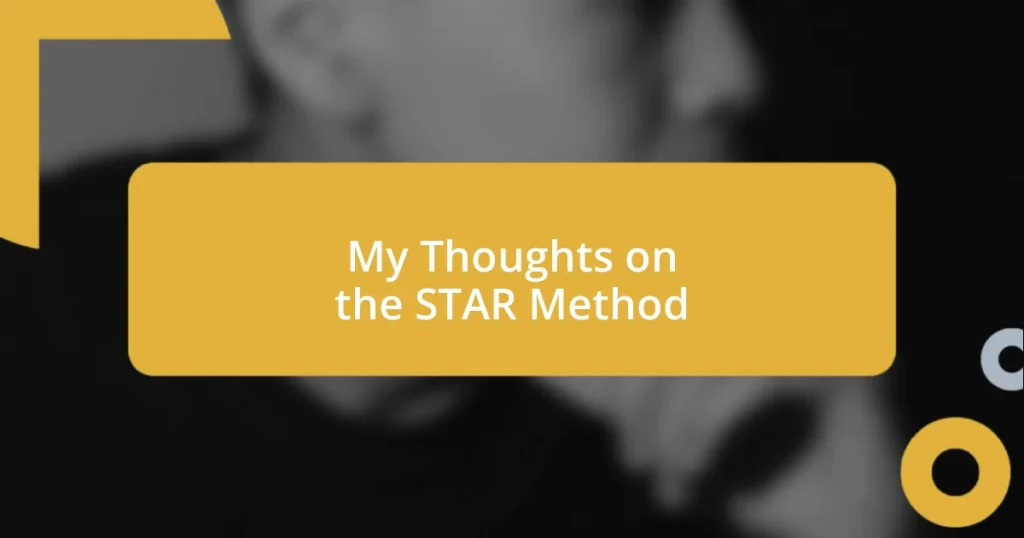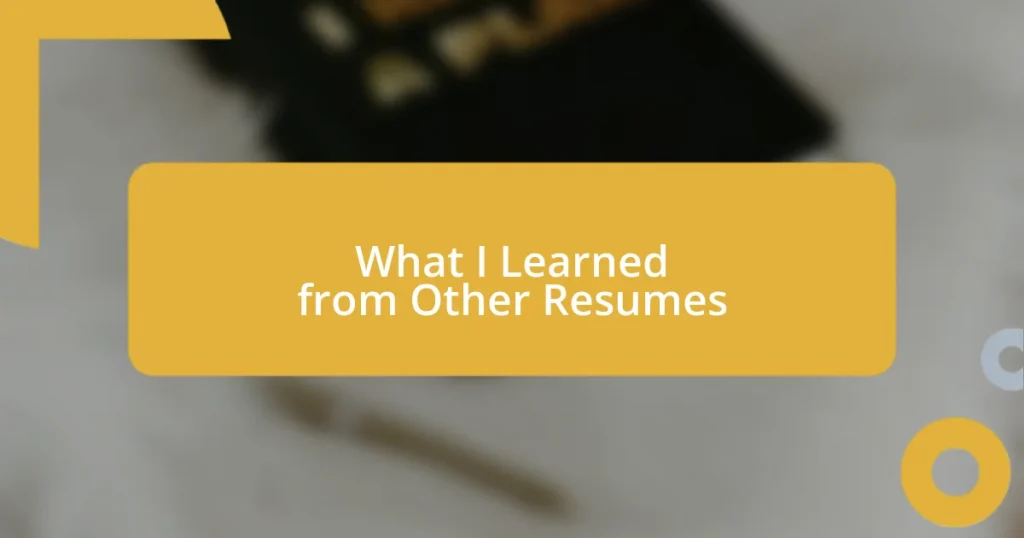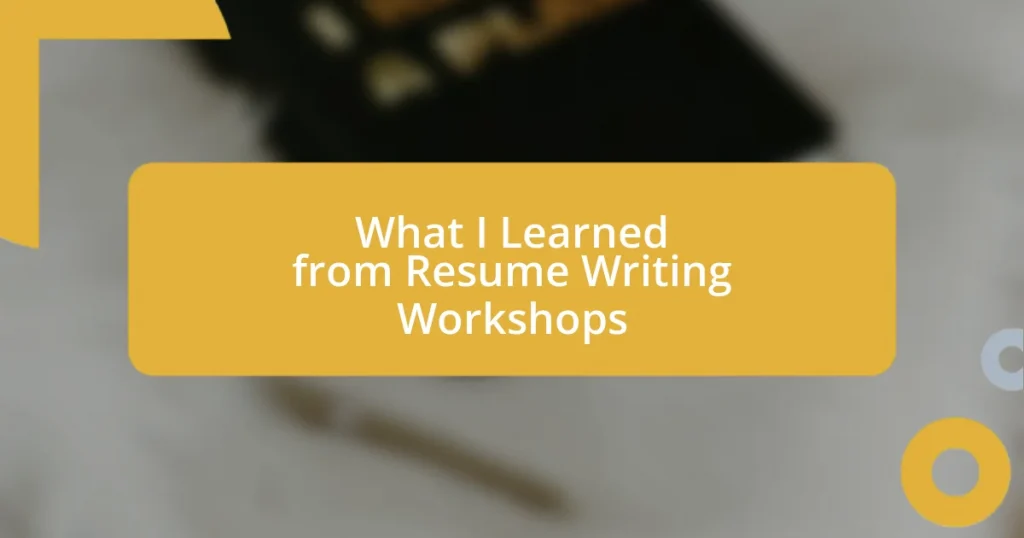Key takeaways:
- The STAR Method (Situation, Task, Action, Result) provides a structured approach for effectively communicating experiences in behavioral interviews.
- Successful responses require clear context and precise descriptions of actions and outcomes, helping interviewers understand a candidate’s impact and contributions.
- Avoid common mistakes like rushing through key details, failing to connect actions to results, and neglecting to share personal learnings from experiences.

Understanding the STAR Method
The STAR Method is a powerful framework designed to help individuals structure their responses in behavioral interviews. By focusing on Situation, Task, Action, and Result, it provides a clear pathway to convey experiences. I remember my first interview where I stumbled through questions because I lacked this structure, leaving me frustrated and feeling unprepared.
When you grasp the STAR Method, it simplifies storytelling about your past experiences. Imagine you’re asked about a challenge you faced—by breaking down your response into those four components, you create a narrative that’s both succinct and impactful. I learned this firsthand when I outlined my approach to a project I managed, which helped me highlight my problem-solving skills effectively.
Ultimately, the STAR Method can transform how you present yourself. Have you ever felt like your accomplishments went unnoticed because you couldn’t frame them clearly? I’ve been there, too. But once I became comfortable using the STAR framework, I found I could articulate my success stories in a way that truly resonated with interviewers and left a lasting impression.

How to Structure Your Response
When structuring your response using the STAR Method, I find that starting with the Situation sets the stage perfectly. You want to paint a clear picture, so I remember the time I described a conflict within my team that required mediation. It was crucial to establish not just what happened, but also the context surrounding it, which made my story more relatable and engaging.
Next comes the Task, where you clarify your responsibilities. This part is often overlooked, yet it’s vital. In one of my past interviews, I mentioned my role in revamping a marketing strategy. Highlighting my specific tasks enabled the interviewer to understand the weight of my contributions. Without this clarity, it can be easy for interviewers to overlook key details that signify your leadership.
As you transition into the Action and Result, think of it as unfolding a story with a clear resolution. For example, I once ended an answer with how our new marketing strategy led to a 20% increase in sales within three months. I could see the interviewer’s interest piqued, as tangible results are often what they want to hear. When crafting these elements, remember: the more precise and confident you are, the more impactful your response will be.
| STAR Component | Description |
|---|---|
| Situation | Set the context for your story; where and when did it happen? |
| Task | Explain what your responsibilities were in that situation. |
| Action | Describe the specific actions you took to address the situation. |
| Result | Share the outcomes and what you learned from the experience. |

Examples of STAR Method Answers
Absolutely, let’s dive into some practical examples that perfectly illustrate how to apply the STAR Method effectively.
One memorable situation for me was when I was part of a team tasked with improving our customer service processes. We faced an alarming drop in satisfaction ratings, which created a sense of urgency. Here’s how I structured my answer using the STAR method:
- Situation: Our team noticed that customer satisfaction ratings had plummeted by 30% over a quarter.
- Task: I was assigned to gather feedback and propose actionable solutions to improve our service.
- Action: I organized focus group discussions and analyzed customer feedback, leading to the introduction of a new training program for our staff.
- Result: Within two months, we saw a dramatic increase, with satisfaction ratings climbing back up by 25%. This experience left me feeling proud of our team’s impact and taught me the importance of listening to customer needs.
In another instance, I recall a project where we had to launch a new product under a tight deadline. The pressure was palpable, and I knew I had to step up. Here’s how I recounted that experience:
- Situation: We were tasked with launching a product in just eight weeks due to an unexpected market opportunity.
- Task: I took on the responsibility of coordinating the various departments to ensure smooth execution.
- Action: I set up daily check-ins and cross-functional teams to streamline communication and keep us on track.
- Result: We successfully launched the product on time, achieving our sales target within the first month. That experience reinforced my belief in the power of teamwork and effective communication.
These examples not only convey the content clearly but also reflect personal growth and success, making your responses memorable.

Common Mistakes to Avoid
One common mistake I see candidates make is rushing through the Situation and Task phases. I remember a time when I glossed over details, thinking they were unnecessary. This left the interviewer confused about the context of my actions. Always take the time to paint a vivid picture; clarity is key.
Another pitfall is failing to connect the Result to the Action taken. I once described a project without emphasizing how my specific contributions led to successful outcomes. Instead of celebrating my role, the interviewer seemed more interested in the end results, leaving me feeling like I missed an opportunity. It’s crucial to bridge that gap to showcase your impact effectively.
Lastly, I’ve noticed some individuals forget to reflect on their learnings from a past situation. I often share what I learned from a significant project I led, as it demonstrates personal growth and adaptability. What can you take away from your experiences? Failing to highlight this insight can leave your responses feeling incomplete, lacking the depth interviewers often look for.















